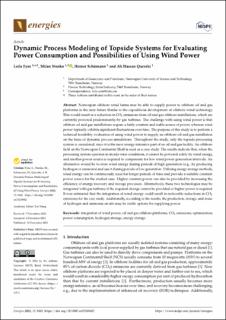| dc.contributor.author | Eyni, Leila | |
| dc.contributor.author | Stanko Wolf, Milan Edvard | |
| dc.contributor.author | Schümann, Heiner | |
| dc.contributor.author | Querishi, Ali Hassan | |
| dc.date.accessioned | 2023-01-20T09:13:19Z | |
| dc.date.available | 2023-01-20T09:13:19Z | |
| dc.date.created | 2022-12-19T16:18:09Z | |
| dc.date.issued | 2022 | |
| dc.identifier.citation | Energies. 2022, 15 (24), 1-16. | en_US |
| dc.identifier.issn | 1996-1073 | |
| dc.identifier.uri | https://hdl.handle.net/11250/3044857 | |
| dc.description.abstract | Norwegian offshore wind farms may be able to supply power to offshore oil and gas platforms in the near future thanks to the expeditious development of offshore wind technology. This would result in a reduction in CO2 emissions from oil and gas offshore installations, which are currently powered predominantly by gas turbines. The challenge with using wind power is that offshore oil and gas installations require a fairly constant and stable source of power, whereas wind power typically exhibits significant fluctuations over time. The purpose of this study is to perform a technical feasibility evaluation of using wind power to supply an offshore oil and gas installation on the basis of dynamic process simulations. Throughout the study, only the topside processing system is considered, since it is the most energy-intensive part of an oil and gas facility. An offshore field on the Norwegian Continental Shelf is used as a case study. The results indicate that, when the processing system operates in steady-state conditions, it cannot be powered solely by wind energy, and another power source is required to compensate for low wind power generation intervals. An alternative would be to store wind energy during periods of high generation (e.g., by producing hydrogen or ammonia) and use it during periods of low generation. Utilizing energy storage methods, wind energy can be continuously used for longer periods of time and provide a suitable constant power source for the studied case. Higher constant power can also be provided by increasing the efficiency of energy recovery and storage processes. Alternatively, these two technologies may be integrated with gas turbines if the required storage cannot be provided or higher power is required. It was estimated that the integration of wind energy could result in noticeable reductions in CO2 emissions for the case study. Additionally, according to the results, the production, storage, and reuse of hydrogen and ammonia on-site may be viable options for supplying power. | en_US |
| dc.language.iso | eng | en_US |
| dc.publisher | MDPI | en_US |
| dc.rights | Navngivelse 4.0 Internasjonal | * |
| dc.rights.uri | http://creativecommons.org/licenses/by/4.0/deed.no | * |
| dc.subject | energy storage | en_US |
| dc.subject | hydrogen storage | en_US |
| dc.subject | power consumption | en_US |
| dc.subject | optimization | en_US |
| dc.subject | CO2 emissions | en_US |
| dc.subject | oil and gas offshore platforms | en_US |
| dc.subject | integration of wind power | en_US |
| dc.title | Dynamic Process Modeling of Topside Systems for Evaluating Power Consumption and Possibilities of Using Wind Power | en_US |
| dc.title.alternative | Dynamic Process Modeling of Topside Systems for Evaluating Power Consumption and Possibilities of Using Wind Power | en_US |
| dc.type | Peer reviewed | en_US |
| dc.type | Journal article | en_US |
| dc.description.version | publishedVersion | en_US |
| dc.rights.holder | Copyright: © 2022 by the authors. Licensee MDPI, Basel, Switzerland. This article is an open access article distributed under the terms and conditions of the Creative Commons Attribution (CC BY) license (https:// creativecommons.org/licenses/by/ 4.0/). | en_US |
| dc.source.pagenumber | 16 | en_US |
| dc.source.volume | 15 | en_US |
| dc.source.journal | Energies | en_US |
| dc.source.issue | 24 | en_US |
| dc.identifier.doi | 10.3390/en15249482 | |
| dc.identifier.cristin | 2095367 | |
| dc.source.articlenumber | 9482 | en_US |
| cristin.ispublished | true | |
| cristin.fulltext | original | |
| cristin.qualitycode | 1 | |

